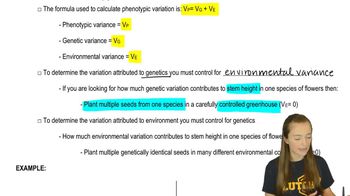Table of contents
- 1. Introduction to Genetics51m
- 2. Mendel's Laws of Inheritance3h 37m
- 3. Extensions to Mendelian Inheritance2h 41m
- 4. Genetic Mapping and Linkage2h 28m
- 5. Genetics of Bacteria and Viruses1h 21m
- 6. Chromosomal Variation1h 48m
- 7. DNA and Chromosome Structure56m
- 8. DNA Replication1h 10m
- 9. Mitosis and Meiosis1h 34m
- 10. Transcription1h 0m
- 11. Translation58m
- 12. Gene Regulation in Prokaryotes1h 19m
- 13. Gene Regulation in Eukaryotes44m
- 14. Genetic Control of Development44m
- 15. Genomes and Genomics1h 50m
- 16. Transposable Elements47m
- 17. Mutation, Repair, and Recombination1h 6m
- 18. Molecular Genetic Tools19m
- 19. Cancer Genetics29m
- 20. Quantitative Genetics1h 26m
- 21. Population Genetics50m
- 22. Evolutionary Genetics29m
20. Quantitative Genetics
Analyzing Trait Variance
Problem 17d
Textbook Question
Two pure-breeding wheat strains, one producing dark red kernels and the other producing white kernels, are crossed to produce F₁ with pink kernel color. When an F₁ plant is self-fertilized and its seed collected and planted, the resulting F₂ consist of 160 plants with kernel colors as shown in the following table. Kernel Color Number White 9 Dark red 12 Red 39 Light pink 41 Pink 59 Based on the F₂ progeny, how many genes are involved in kernel color determination?
 Verified step by step guidance
Verified step by step guidance1
<insert step 1: Understand that the problem involves determining the number of genes involved in kernel color determination based on the phenotypic ratio observed in the F₂ generation.>
<insert step 2: Recognize that the F₁ generation shows an intermediate phenotype (pink), suggesting incomplete dominance or additive gene action.>
<insert step 3: Analyze the phenotypic ratios in the F₂ generation. The presence of multiple phenotypes (white, light pink, pink, red, dark red) suggests polygenic inheritance.>
<insert step 4: Use the observed phenotypic ratios to hypothesize the number of genes involved. In polygenic inheritance, the number of phenotypic classes is often related to the number of genes.>
<insert step 5: Apply the formula for the number of phenotypic classes in polygenic inheritance, which is 2n + 1, where n is the number of genes. Compare the number of observed phenotypic classes to determine n.>
Recommended similar problem, with video answer:
 Verified Solution
Verified SolutionThis video solution was recommended by our tutors as helpful for the problem above
Video duration:
2mPlay a video:
Was this helpful?
Key Concepts
Here are the essential concepts you must grasp in order to answer the question correctly.
Mendelian Inheritance
Mendelian inheritance refers to the principles of heredity established by Gregor Mendel, which include the concepts of dominant and recessive traits. In this scenario, the dark red and white kernel colors represent two contrasting traits, with the pink color in the F₁ generation indicating incomplete dominance. Understanding these principles helps in predicting the ratios of phenotypes in the F₂ generation.
Recommended video:
Guided course

Organelle Inheritance
Phenotypic Ratios
Phenotypic ratios are the relative frequencies of different phenotypes in a given population. In this case, the F₂ generation's kernel colors can be analyzed to determine the underlying genetic mechanisms. By examining the observed ratios of the different kernel colors, one can infer the number of genes involved in determining the trait, as certain ratios correspond to specific genetic models.
Recommended video:
Guided course

Mutations and Phenotypes
Polygenic Inheritance
Polygenic inheritance occurs when multiple genes influence a single trait, resulting in a continuous range of phenotypes. In the context of the kernel colors, the variation observed in the F₂ generation suggests that more than one gene is involved in kernel color determination. Analyzing the distribution of colors can help deduce the number of genes contributing to this trait, often leading to a more complex inheritance pattern than simple Mendelian ratios.
Recommended video:
Guided course

Organelle Inheritance

 8:34m
8:34mWatch next
Master Analyzing Trait Variance with a bite sized video explanation from Kylia Goodner
Start learningRelated Videos
Related Practice


